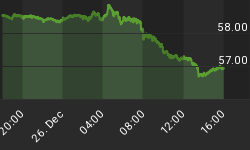I am no bear on commodities, but I do believe real assets are about to suffer a sharp correction. In fact, the correction will likely apply to all asset classes. The catalyst? Realization by traders that the Fed has no intention of halting rate increases any time soon. Although the Fed has not stated so publicly, their primary motivation these days is the defense of the U.S. Dollar. Only through a strong dollar can the United States continue to sell debt cheaply and preserve its global hegemony.
There has been widespread perception that an end is near for the current cycle of rate hikes. This perception has been molded by a very clever public relations game on the part of the Fed. For nearly two years they have stuck to "measured" rate hikes while saying "inflation appears to be contained," implying that rates don't need to go far... but they keep going. To support the charade, Fed governors will occasionally let slip phrases such as "the current cycle of rate hikes is in the ninth inning" (stated 4 hikes ago) or that there is a more than a passive concern about rate hikes going too far.
In fact, the Fed is nowhere near where they would like to take the Fed Funds rate, and they won't stop hiking until forced to do so by crisis. Furthermore, recently faltering prices in long bonds and the U.S. Dollar only provide impetus for the Fed to keep hiking. It may seem counterintuitive, but an extended cycle of rate hikes has been instrumental in keeping prices of long bonds from plunging more than they have. As long as the Fed is perceived, at least globally, as being somewhat defensive on the dollar, the rise in long bond rates will remain somewhat mitigated. Once the Fed relents, it will spell the end of cheap money for the U.S. government. There is no conundrum here.
The global focus on the dollar's viability is evidence by the aforementioned fact that the dollar is falling in conjunction with bonds. Typically, higher U.S. bond yields would create demand for the dollar as participants chase yield. The divergence we are witnessing signifies a growing distaste for the dollar and dollar-based assets.
All News is Bad News for Stocks
Much to the chagrin of bears, just about all news for the passed three years has been interpreted positively for stocks. If the economy were weak, it did not mean that earnings would be hurt, but rather that the Fed would stop hiking rates. If bonds were falling, it did not mean inflation was burgeoning, but rather that industry was strong. In other words, all news was good news.
We are about to enter a period with exactly the opposite psychology. Should the Fed be perceived to be more aggressive than presently expected, stocks will suffer. Likewise, when some sort of crisis spurs the Fed to begin slashing rates, more energy will be spent fretting over the crisis than rejoicing in the rate hikes. Therefore, stocks could find themselves in a no-win environment.
Commodities will likely take a breather, as well. While much of their rise over the passed few years is fundamentally justified, real assets have been the subject of a bit of speculative fervor of late (witness the silver blowout). If perception over the Fed's intentions were to shift toward hawkishness, the speculative portion of recent runs in commodity prices would be deflated. Such a pullback would only set up a beautiful buying opportunity for the next leg up, which would likely ensue after definitive change in Fed policy.
As you can see from the following charts, both stocks and commodities have been losing momentum, as measured by their respective RSIs. The technical environment is set up to support the macro view outlined above.


Commodities and stocks typically move in opposite directions, so one may wonder why both asset classes would go down together. First, they have been moving upwards together for several years, so a mutual respite is not unfathomable. Second, the commodity setback is likely to be sharp, but brief, while the flight from stocks and bonds is likely to be deep and extended. As money flees dollar-based assets (bonds now, stocks soon afterward), money will seek a new realm of safety, meaning real assets, and the commodity bull market will be recognized in earnest.
















